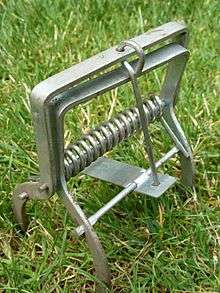Molecatcher

A molecatcher is a person who traps or kills moles in places where they are considered a threat to crops, lawns, or gardens.
History of molecatching

Excavations of Ancient Roman sites have revealed countless earthenware pots that had been set in the ground. It is believed that the pots were filled with water, and acted as traps for moles.
Over time, traps used to catch and kill moles became more advanced and complicated, incorporating weighted wood or cast iron, and eventually sprung steel.
Traditional molecatchers
Traditional molecatchers travelled from farm to farm. The molecatcher's customers would provide food and lodging, as well as a fee for every mole caught. The molecatcher could also earn money by selling the moleskins to fur dealers.
Modern molecatchers
In more recent times, traditional molecatching has given way to the use of poison. Although the use of poison results in moles dying much more quickly and in greater numbers, ethical and environmental concerns have been raised over poison being an inhumane method of pest control, and the possibility of other animals that interact with moles becoming poisoned as well.
Poisoning using strychnine is no longer an approved method of control in the UK, following the withdrawal of the poison from the market in 2006.[1] Fumigation with products based on aluminium phosphide (Trade names 'Talunex' and 'Phostoxin') is still an approved method of control, but may be carried out only by fully trained operatives.
Since the removal of strychnine from the UK market, there has been a revival of traditional molecatching in Britain. Modern traditional mole catchers use traps, and usually charge a 'per-mole' fee, as their forebears did. The price charged reflects the fact that there is no longer a market for moleskins.
Sonic devices have not proven successful in eliminating moles.
Bibliography
- Randa, Arthur (1970). Fenland Molecatcher. Routledge & Kegan Paul. ISBN 0710068026.
- Smith, Guy N. (1980). Moles and Their Control. Saiga Publishing. ISBN 0904558827.
- Atkinson, Rob (2013). Moles. Whittet Books.
References
- ↑ Frances Hubbard (18 April 2015). "Louise used to be a drama teacher. Now she kills moles.". Telegraph.
External links
| Wikimedia Commons has media related to Mole catching. |
- Association of Professional Mole Catchers
- British Traditional Molecatchers Register
- Guild of British molecatchers